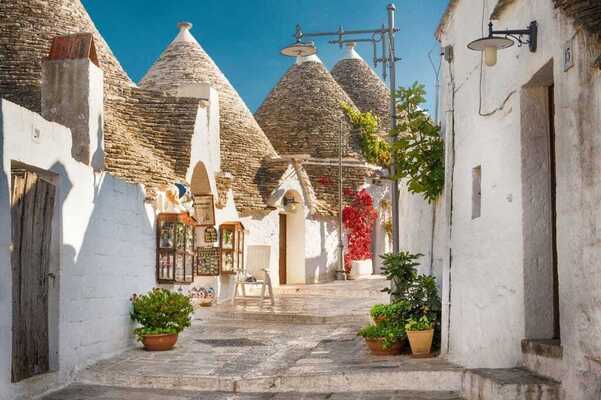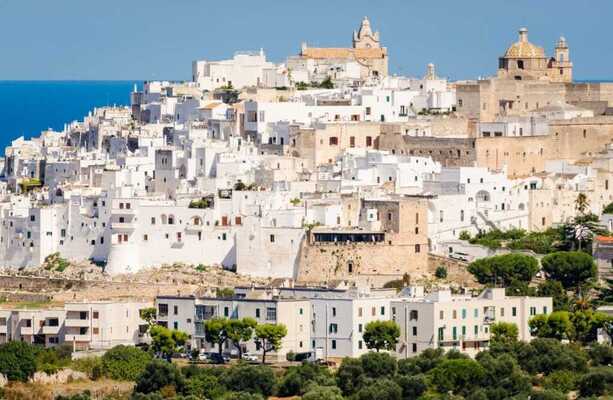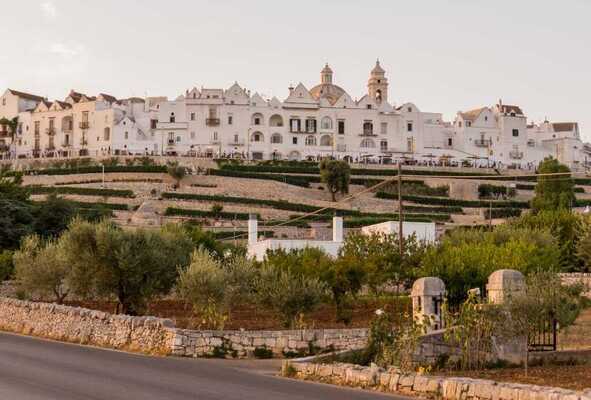Salento farmhouses (“masserie”)
Very often olive tree branches, vine shoots and prickly pear stems hide old scars: abandoned ruins that demonstrate, to us who approach respectfully, the pride of being part of the red and warm land of Salento. The farmhouses (called “masserie“) are the undisputed object of our memory, the testimony of what we are, the pretext to remain linked to our roots in Salento.

History and function of Salento farmhouses
The masseria, from the Latin massa, or “set of estates”, is a rural building settlement typical of the 16th – 17th century, which for a long time represented the most widespread type of company (agricultural-pastoral in nature) in Puglia, becoming full expression of local peasant culture.
Beyond the agricultural aspect, the masserizio phenomenon is linked, without a shadow of a doubt, to a defensive function: after the fall of the Byzantine Empire, in 1453, the Salento peninsula became a frequent destination for looting and pirate incursions. During the 16th century, to overcome such attacks, Charles V of Habsburg decided to strengthen the Adriatic and Ionian coast by implementing a defense plan which led to the construction of towers and walls around the farms which for this reason were defined as “fortified“.
The “fortified farm” is a structure built in the countryside and isolated from urban centers, with the intention of protecting the safety of its inhabitants, and therefore always protected by a massive fence, the ideal place in which to defend oneself from pirates, by the Saracens and brigands who raged in Southern Italy. This phenomenon is visible throughout the Adriatic coast of Salento, from Brindisi to Otranto and also on the Ionian side, from Capo di Leuca.
It can therefore be stated with certainty that the birth of these rural complexes is linked to the socio-economic context of Southern Italy.
Architecture of the Salento farms
The farms were built taking into account a certain aesthetic and architectural taste, thanks to the skill of craftsmen and bricklayers who worked stone, carparo or tuff. At the same time, these are settlements built with a view to functionality, to make life in the fields less difficult and therefore to lighten the settlers’ fatigue, offer practical solutions and guarantee maximum usability of the environments, in a perfect balance between man and nature, between the artefact and the territory.

The typical layout of the farm in some cases included a construction of the type closed towards the outside and with the openings all facing inside the courtyard or large courtyard. Various rooms were distributed around the courtyard: the farmer’s house, the stables and pens for the animals, the structures intended for the conservation and processing of the products of the land and livestock or stables for the horses or mules as well as the rooms for chickens, rabbits and various farmed birds. Other rooms were used for storing work tools and as a shelter for the owner’s carriages. Furthermore, there were also wells called “pile“, that is, stone containers that contained water for laundry, drinking troughs and granaries for preserves.
The same perimeter walls, without openings, acted as protection against intruders and malicious people, also allowing a possible defense against attacks by bandits.
Generally a part of the building for residential purposes had one or more upper floors in which the “master” and his family lived. The lower floors were used for housing by the farmers and as warehouses for supplies. In most cases a chapel or church was built which was used for various religious functions.
Different types of farm
There are several farm buildings in Salento:
- at court, the farm is built within walls that enclose it, defending it from external threats.
- with a trullo roof: houses and haystacks have a trullo roof and are of different sizes. Some examples are Masseria Ortolini and Masseria Ferrari (residents in Martina Franca).
- with pignon roof: the roof of the house is a pignon, steep roof and the buildings intended for the tasks have a trullo roof.
- linear construction: farms that are characterized by being a single building, with the houses joined to the other buildings.
- a casino: construction that developed in the 19th century and which marks the clearest distinction between the owner’s house and the company (e.g. Luco, Mita).
The Farmer
In these rural sediments they were initially inhabited by farmers, the so-called “massari” (responsible for the agricultural land), who dedicated their lives to the cultivation of products necessary for their sustenance, that is, cultivation of wheat, cereals, olives, in addition to livestock breeding and milk and cheese production.
The farm was not owned by the settler who lived there and cultivated the surrounding lands, but by the landowner who allowed the farmer to stay there with his family, enjoying part of the harvest.
From past to present: the farmhouses in Salento today
From the mid-17th century, some improvements in the agricultural sector allowed the rural environment to be further enhanced, leading to the birth of the farmhouse-villa in Salento.
The farms are therefore enriched with rich portals, balconies and viewpoints, gardens and stucco decorations and frescoed ornaments which transform these rural and spartan structures into small jewels of fine architecture, holiday resorts.
Today they appear on state roads or in the countryside, with grandeur and dignity. Some have been restored and sometimes used for tourism, hosting farmhouses, B&Bs or charming resorts, but also private villas equipped with all comforts. Once productive environments, the oil mills, the mangers, the millstones are restored to allow the most attentive tourists to rediscover the culture and rural tradition.
Rusticity thus becomes an added value of tourism. Others, completely abandoned, experience a difficult and, perhaps, risky solitude, but not without charm, like that of Monteruga. An immense farmhouse in the countryside of San Pancrazio, Salice and Veglie, once the center of intense agricultural activity, and now abandoned.

Alberobello: the City of Trulli
Characterized by an entire neighborhood of trulli, its historical importance and architectural uniqueness, it has been declared a UNESCO heritage site

Ostuni: the “white city”
Picturesque and renowned tourist destination, it boasts a medieval village with winding streets and whitewashed houses. Divided between the old city known as the "land" and the more recent "marina" one, it offers evocative views of stairways, alleys and small squares overlooked by shops, small shops and typical restaurants.

Locorotondo – among the most beautiful village in Puglia
Locorotondo, a small Apulian village where you can get lost in the alleys of the historic center admiring the characteristic houses with sloping roofs and centuries-old churches.
